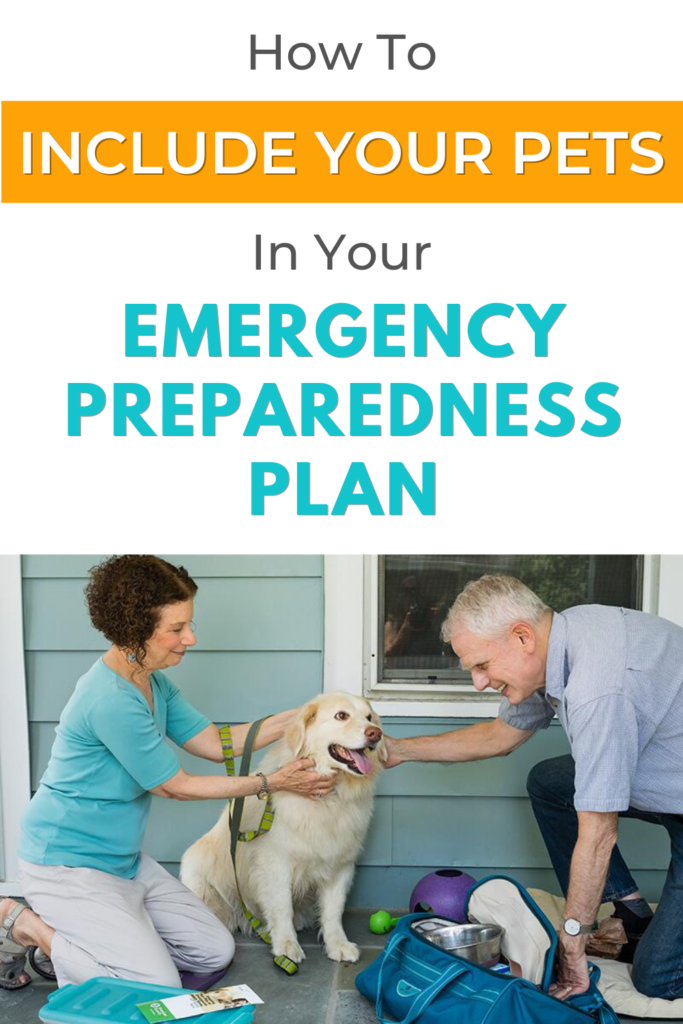June is National Pet Preparedness Month: a reminder that we should all be prepared and have a plan for what to do in the case of an emergency or natural disaster. No-one likes to think that they could be faced with an emergency… it always happens to someone else. But, the truth is, having an emergency preparedness plan, could save the lives of your family, including your pets.
In September 2021, the American Society for the Prevention of Cruelty to Animals (the ASPCA) released data from a national survey which showed that more than 1 in 5 pet owners have had to evacuate their homes due to an emergency or disaster. What is most alarming from this data is that nearly half of those people… yes, you read that correctly… nearly 50% of those pet owners left at least one pet behind during the evacuations.
In the event of a disaster, leaving a pet behind exposes them to a wide range of life-threatening scenarios. Not only are they alone and frightened, they face the potential inability to escape the flood, fire, hurricane, etc. They will be without fresh food and water for extended periods of time – if they happen to survive at all. A pet, who is a member of your family, should not be left out of planning for a disaster. They rely on you for protection… and they deserve to be protected.
The ASPCA survey data shows pet owners need to have an emergency preparedness plan which includes their pets. When you do create a plan, write it down. Writing it down makes things clear in a stressful situation should you ever need to use it. Those that look after your pet, such as a pet sitter or friend, should know about your plan in the event you are away from home when disaster strikes.
Each type of disaster will require a different plan, but the first step in all cases remains the same… start to think about a plan. The sooner you develop an emergency preparedness plan, which includes your pets, the more likely it will be that your family will be safe if faced with an emergency.
Remember… if a situation is not safe for you, it’s not safe for your pets. Don’t leave your pet behind!
IDENTIFICATION
It’s critically important to ensure your pets have proper identification and that all their information is up-to-date. In case you should get separated, their identification should include their name, your name and contact information. Remember to include your cell number since you may not be at home. You could also include contact information for someone else that may be able to care for your pet… adding another level of protection.
Consider having your pet microchipped. If your pet is microchipped, ensure all contact information is current at the microchip company. Remember if you move or change your contact information, contact them to update their records.
Place a sticker on your door or window to show the number and types of pets that live at your home. These stickers make it easy for first responders and rescuers to quickly identify how many dogs, cats, birds, etc that live in your home.
Have an updated photo of your pet… or a cute selfie of your and your pet… and keep that, along with their vaccination and health records together. This photo can be used as identification if your pet should get lost.
HEALTH & IMMUNIZATION RECORDS
For each pet, keep a copy of their health history, vaccination records and contact information for your veterinarian. This would be the perfect place to keep the photo of each pet and/or you and your pet(s). A digital copy of these items if fine, but remember, you may not have access to electricity or internet. Always keep a hard copy!
You should keep this paperwork in your pet’s emergency go bag (see below) in case you have to evacuate quickly.
RESEARCH PET FRIENDLY PLACES
Research pet friendly places that you can evacuate to, especially if you happen to live in an area that is prone to flooding, wildfires or other natural disasters. Search for hotels and motels which allow pets – they are becoming more common. Alternatively, you could ask friends or family members to help with your pet should you need it. Whichever route you go be sure to keep their contact information somewhere easily accessible… preferably in your pet’s go bag.
A good place to start your research are websites like BringFido.com and GoPetFriendly.com. Both offer the ability to search for pet-friendly lodging options around your area.
EMERGENCY “GO BAG” / KIT

What’s an emergency go bag? It’s an emergency kit that includes items you need to survive should you have to evacuate your home. It should be already packed and easy to take with you in case you need to leave immediately. You should have an emergency go bag for yourself, but your pets need one too!
If you already have an emergency go bag – for you and your pets – use this month as an opportunity to replace old food and medication and make sure that photos and emergency contact information/records are all up to date. If you haven’t yet created a bag you can use this list to help get you started
Along with what is listed above, your pet’s emergency go bag should include:
- 7 to 10 days worth of food (rotate regularly… if you use canned food remember to pack a can opener!)
- 7 to 10 days worth of bottled water (rotate regularly)
- Medications (rotate regularly so that medication doesn’t expire)
- Food and water bowls (collapsable saves space)
- Extra collar, harness, and leash for each pet
- Plastic bags and poop bags
- Paper towels
- Pet shampoo, brush, etc (in case your pet needs to be cleaned up)
- Blankets and/or bedding (familiar items help to reduce stress and provide comfort for your pet)
- A favorite toy or chew (these items give your pet a sense of security and helps to reduce stress)
- Cat litter
- Litter pans
- Flashlight (with extra batteries)
- A pet carrier for each pet (a properly sized pet carrier is large enough for the pet to stand up, turn around and comfortably lie down)
- First aid kit with pet-specific supplies
DON’T FORGET YOUR FARM ANIMALS
If you have pets like horses, pigs, goats, etc on your property don’t forget them in your emergency preparedness planning. In the case of an emergency farm friends need to be taken care of too!
Here are some steps that FEMA recommends for planning to take care of larger animals in the case of a disaster.
- Ensure all animals have some form of identification.
- Evacuate animals earlier, when possible. Map out primary and secondary routes in advance.
- Have available the vehicles and trailers needed for transporting and supporting each type of animal. Also have experienced handlers and drivers.
- Ensure destinations have food, water, veterinary care and handling equipment.
- If evacuation is not possible, animal owners must decide whether to move large animals to a barn or turn them loose outside.
When you return home after a disaster it is important to keep your pets on a leash when you are outside. What they knew as their home may have changed. Your home may not only look different – with dangerous debris around – but it may also smell different. Those new smells may interest your pet enough that they run off… but since the landscape has changed they may not be able to find their way home again.
HELPFUL RESOURCES
Here is a list of resources that you may find helpful in your emergency preparedness planning. Hopefully you will never be in a position to need to use your emergency preparedness plan… but it is better to be prepared now rather than have to “wing it” if the worst was to happen. Having a plan could save the lives of you, your family and your pets.
A great video from FEMA – Preparing Makes Sense for Pet Owners:
Prepare your Pets for Disasters (Pamphlet)
Prepare Your Pets For Disaster (US Government)
Pet Disaster Preparedness (American Red Cross)
Emergency Preparedness for Farm Animals (Canadian Government)







0 Comments